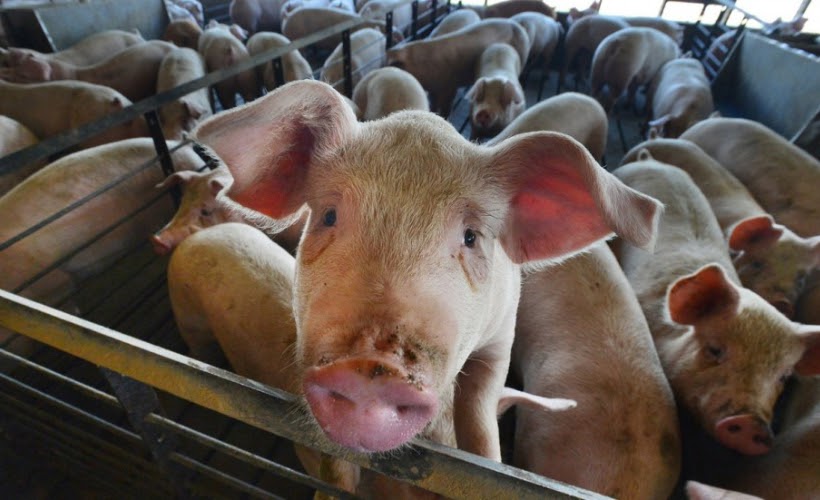‘Very complicated and very tough’ — China’s African swine fever challenge

In its second breakout from its indigenous environment in the sub-Sahara, African swine fever (ASF) has finally achieved what many veterinary scientists and virologists have long predicted was terrifyingly inevitable. It is on the move throughout China, home to more than half the world’s pigs.
As previously reported in The China Project, China’s ministries of agriculture, transport, and public security have warned that “a situation previously described as under control had become ‘very serious’” (十分严峻 shífēn yánjùn).
How ASF (非洲猪瘟 fēizhōu zhūwēn) made its way into China in early August remains a mystery. Imports from infected Eastern Europe, from infected Russia, or by wild boar somewhere along the 2,500-mile Sino-Russian border are all possibilities. But one thing is certain: According to virologists and specialists in pig disease, now that the virus is in China, its mode of transmission will change – and at unprecedented speed.
To understand why this is so, it is necessary to look briefly at the known history of the virus and at the nature of the virus itself.
First identified in the early 20th century, virologists speculate that ASF happily coexisted with soft ticks and African warthogs for centuries, perhaps even millennia, in what epidemiologists call a sylvatic relationship — in other words, the pathogen was sustained by transmission through asymptomatic wild animals. But when infected ticks or asymptomatic boars encounter domesticated pigs, the results are far from asymptomatic. They are devastating: Infected domestic pigs hemorrhage in every organ and from every orifice, with a typical 100 percent mortality rate within six to 10 days.
As bad for pigs as it is, all major global health authorities have declared the disease not a human threat. The only exception is a solitary — and overwhelmingly ignored — cry for attention from a virologist in Latvia in 2014. Moreover, until recently, ASF has been a very slow-moving disease, partly because it is so deadly:
“Usually death will follow within three to six days. This means that almost all infected hosts will die very quickly, which means that the virus will cease to exist very soon because it kills its host,” explains Klaus Depner, head of the International Animal Health Team at the Friedrich-Loeffler-Institut on the island Riems in northern Germany.
But in 2007, ASF was found in pigs in Georgia, heart of the Caucasian crossroads between Europe and Western Asia. Depner, who began studying the means of transmission in Europe, said he found that it had become a “man-made disease”:
What happened is that infected meat made it to the market. When many pigs started to die, they were sent to slaughter. Pig prices dropped, cheap meat entered the market and the meat made its way into homes — and into suitcases. This is how the virus dispersed. The virus spread along the main roads, the transport routes. This spread bears a 100 percent human mark.
Now ASF is in China, the world’s biggest farmer and consumer of pork. More than half the estimated 430–470 million domestic swine in China are backyard pigs with next to no biosecurity and often with no veterinary experts within short reach. Pigs that die of the disease too quickly to be rushed to market are often dumped in the nearest river. Such was the case in 2013, as was widely reported, when more than 16,000 dead hogs floated through Shanghai in the Huangpu River (黄浦江 huángpǔ jiāng).
The ASF virus in the natural water supply puts even facilities with rigid biocontrol at risk, as reported in Europe.
There is no cure
Chris Oura, professor of veterinary virology at the School of Veterinary Medicine, University of the West Indies, Trinidad and Tobago, has long been studying the virus and describes it as “very large, very complicated and very tough.”
Right now, the development of either a vaccine or a cure is a long-distant proposition. The ASF virus “has something like 165 proteins and we’ve only looked at something like a third of these,” said Oura. The number of proteins is a measure of the complexity of a virus, and 100 to 200 is considered highly complex.
“A lot of work has to be done to understand the biology behind this virus and how it does what it does. It’s extremely resistant in the environment: You can smoke it, cook it, and it persists,” said Oura. Although thorough cooking kills the AFS virus, stir-frying often leaves pork undercooked. Leftovers in China end up as pig swill, a perfect vector for ASF.
Meanwhile, just how tough is “very tough”? The ASF virus, studies have shown, can survive in isolation from its host — in dust, on the tires of trucks, in empty shipping containers, on the soles of shoes, and on clothes for 30 to 40 days — and at temperatures of up to 140 degrees Fahrenheit (60°C). It can survive in cured pork for months and in Parma ham for up to a year.
What this means for already high levels of time-consuming security at airports and borders remains to be seen, but it seems certain to reduce ease of mobility at some point in the not-too-distant future, especially if the virus travels — as it inevitably will — to the U.S.
The Food and Agriculture Organization of the United States Regional Office for the Asia Pacific warned in a press release as early as July of this year that ASF is here to stay and its trans-border transmission was inevitable: “It’s no longer ‘if’ that will happen but when, and what we can do collaboratively to prevent and minimize the damage,” the report said.
Hand-wringing over China’s emergent expansionary agenda, its “debt diplomacy,” and the Belt and Road Initiative has focused largely on China’s model of governance and its goal to reshape the global order. An epizootic — that’s an epidemic among animals — such as ASF puts China’s plans to connect the world via thousands of miles of roads, railways, and shipping lanes in a new light.
First, the pigs; what next?





